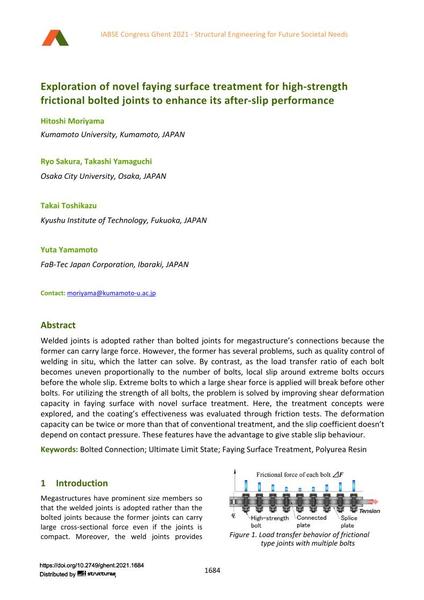Exploration of novel faying surface treatment for high-strength frictional bolted joints to enhance its after-slip performance

|
|
|||||||||||
Bibliografische Angaben
| Autor(en): |
Hitoshi Moriyama
(Kumamoto University, Kumamoto, JAPAN)
Ryo Sakura (Osaka City University, Osaka, JAPAn) Takashi Yamaguchi (Osaka City University, Osaka, JAPAn) Takai Toshikazu (Kyushu Institute of Technology, Fukuoka, JAPAN) Yuta Yamamoto (FaB-Tec Japan Corporation, Ibaraki, JAPAN) |
||||
|---|---|---|---|---|---|
| Medium: | Tagungsbeitrag | ||||
| Sprache(n): | Englisch | ||||
| Tagung: | IABSE Congress: Structural Engineering for Future Societal Needs, Ghent, Belgium, 22-24 September 2021 | ||||
| Veröffentlicht in: | IABSE Congress Ghent 2021 | ||||
|
|||||
| Seite(n): | 1684-1691 | ||||
| Anzahl der Seiten (im PDF): | 8 | ||||
| DOI: | 10.2749/ghent.2021.1684 | ||||
| Abstrakt: |
Welded joints is adopted rather than bolted joints for megastructure’s connections because the former can carry large force. However, the former has several problems, such as quality control of welding in situ, which the latter can solve. By contrast, as the load transfer ratio of each bolt becomes uneven proportionally to the number of bolts, local slip around extreme bolts occurs before the whole slip. Extreme bolts to which a large shear force is applied will break before other bolts. For utilizing the strength of all bolts, the problem is solved by improving shear deformation capacity in faying surface with novel surface treatment. Here, the treatment concepts were explored, and the coating’s effectiveness was evaluated through friction tests. The deformation capacity can be twice or more than that of conventional treatment, and the slip coefficient doesn’t depend on contact pressure. These features have the advantage to give stable slip behaviour. |
||||
| Stichwörter: |
Schraubverbindung
|
||||
| Copyright: | © 2021 International Association for Bridge and Structural Engineering (IABSE) | ||||
| Lizenz: | Die Urheberrechte (Copyright) für dieses Werk sind rechtlich geschützt. Es darf nicht ohne die Zustimmung des Autors/der Autorin oder Rechteinhabers/-in weiter benutzt werden. |
||||
